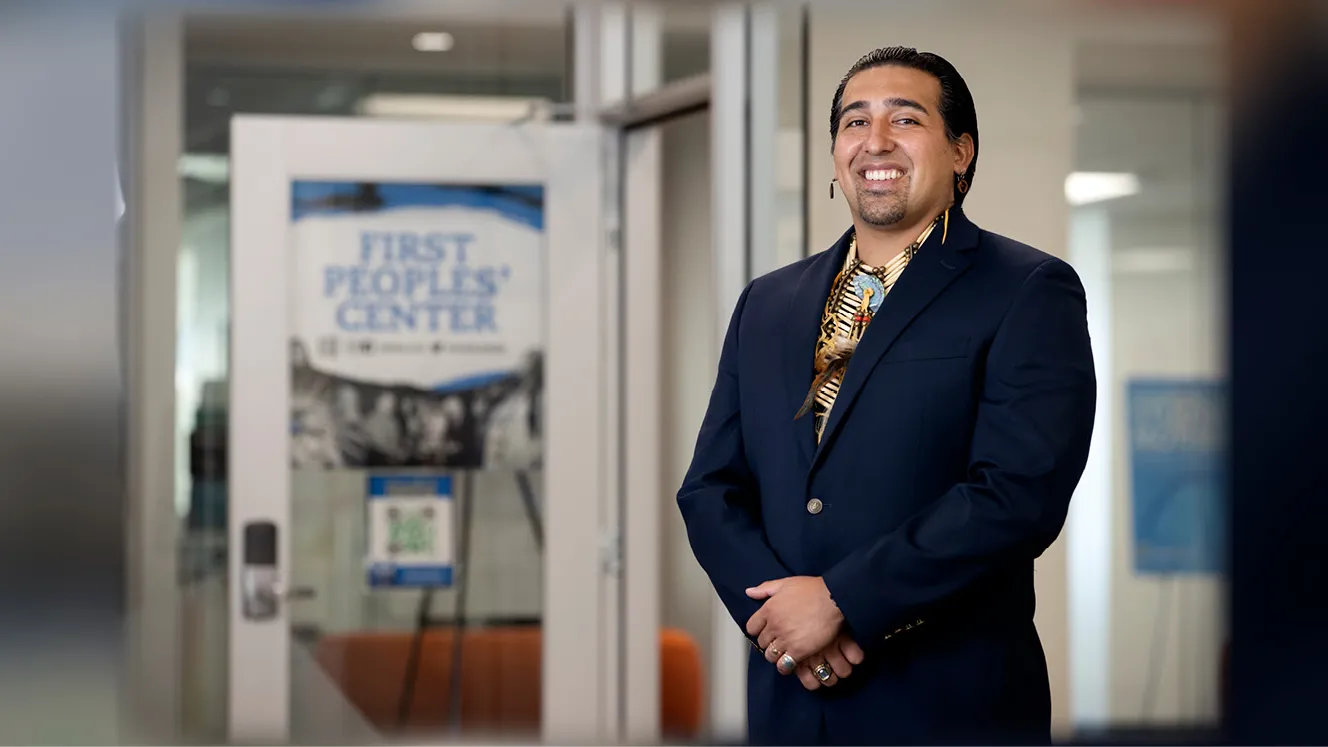Joe Gutierrez | Office of Strategic Communication | (909) 537-3007 | joeg@csusb.edu


Cal State San Bernardino’s First Peoples’ Center coordinator Carlos Two Bears Gonzales said his goal is to make sure the university’s indigenous students, as well as other students, are taken care of and that they receive and have access to the resources they need to succeed at the university.
A history educator and Native American studies lecturer, Gonzales of the Mexica peoples, was appointed coordinator to the First Peoples’ Center, which is dedicated to supporting the academic achievement and personal success of First People students on campus.
“I want them to know they have support,” said Gonzales, remembering his experiences as a student at Cal Poly Pomona’s Native American Student Center and how well he was treated. “I remember that feeling of knowing when I went into that center I could ask any questions I had. I didn’t have any fear of saying, ‘Hey, I need help.’ It felt like a safe haven. My goal is to pay it forward and take what I learned and bring that to our students here. I want them to know that this is a safe place.”
Gonzales said that especially includes mental health.
“I’m here to promote mental health for anyone that wants to walk through this door and talk about anything that might be on their minds. But for the native community, we unfortunately lead the country in suicide, and we lead it in alcohol abuse, drug abuse, domestic violence,” Gonzales said. “The rap sheet is far too long, unfortunately.”
Gonzales said suicide affected his family when in a span of four months, two family members took their own lives.
“It forever changed me. And that’s when I realized the importance of mental health in our community and outside our community,” Gonzales said.
A Cal Poly Pomona alumnus, Gonzales majored in gender, ethnicity and multicultural studies with a concentration in Native American studies. He said at the time, his goal after graduation was to be a head football coach and, as a history nerd, to teach history at the high school level and ultimately teach a Native American history class.
After talking with one of his elementary school principals about his future, Gonzales instead created a visiting lecturer program, where he would give 45-minute talks to students at high schools, middle and elementary schools in topics that included Thanksgiving and Columbus Day, which he called two of the most romanticized things in history books. Gonzales said he would talk to the students about “facts that they’re not going to hear about in their history books.”
Gonzales said his talks included the Navajo Code Talkers, who during World War II used the Navajo language to transmit fast, secure coded messages and how other Native American tribes served as code talkers. He would also talk about stereotypes and stigmas.
“Do all Indians, like, live in teepees? Did they used to live in teepees? That type of stuff. The red man stigma, the logos on tobacco, on certain cigarettes and chewing tobacco,” Gonzales said. “The other subjects I would talk about was, I can’t tell you how many times I’ve been asked, ‘You get free money, you get to go to college for free?’ No. Everyone thinks that just all natives, all indigenous folks, for whatever reason, receive free money, receive things tax free. Yeah, you know, get big fat paychecks every month, and that’s just not the case.”
He said he learned about the coordinator’s job while talking to Robert Levi, the university’s Native Elder-in-residence, at a Native American event. Levi told him about three job openings focusing on the indigenous community at the university, including the coordinator position, and “telling me about the good stuff that’s happening here on campus and talking about the positions that are opening up for the Native American community.”
That night, Gonzales applied for all three positions and was eventually hired as coordinator.
He is also quick to point out that the First Peoples’ Center will be open to everyone.
“This center is not just going to be strictly for first peoples, Native American Indians. I want this center to be open to anyone that identifies or is an ally to the indigenous community,” Gonzales said. “Working together and being stronger together is the only way things are going to get done.”
He pointed to a quote he has on a center wall that reads “A single bee is ignored, but when millions come together, even the bravest run in fear.”
“That’s what I want for the center. I want unity. I want these other centers to know that I’m here for them, too. I’m here for these students. More importantly, without these students, we don’t have these centers. Without the students, we don’t have this university going.
“I want to help open eyes. I want to help open up hearts. I’ll be cheesy and say, I want to open up hearts, too, because the more we know about each other, the more respect that we’ll have for each other,” Gonzales said. “You’ll never really be able to truly see how someone else is living until you learn their history and know what they’ve gone through.”
Located in the Santos Manuel Student Union North, the First Peoples’ Center supports the academic achievement and personal success of indigenous students and celebrates Native American culture at CSUSB. The center focuses on enhancing Native college student experiences, promotes community engagement, and provides opportunities for student learning through cultural programs and traditional activities. Learn more at the First Peoples’ Center website.